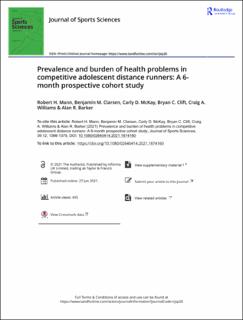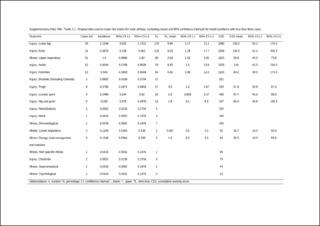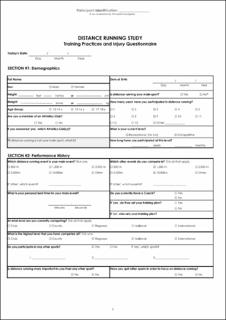| dc.contributor.author | Mann, Robert H. | |
| dc.contributor.author | Clarsen, Benjamin Matthew | |
| dc.contributor.author | Clift, Bryan C. | |
| dc.contributor.author | Williams, Craig A. | |
| dc.contributor.author | Barker, Alan R. | |
| dc.contributor.author | McKay, Carly D. | |
| dc.date.accessioned | 2021-06-11T14:03:24Z | |
| dc.date.available | 2021-06-11T14:03:24Z | |
| dc.date.created | 2021-03-18T14:06:45Z | |
| dc.date.issued | 2021 | |
| dc.identifier.citation | Journal of Sports Sciences. 2021, 39(12), 1366-1375. | en_US |
| dc.identifier.issn | 0264-0414 | |
| dc.identifier.uri | https://hdl.handle.net/11250/2759027 | |
| dc.description | This is an Open Access article distributed under the terms of the Creative Commons Attribution License (http://creativecommons.org/licenses/by/4.0/), which permits unrestricted use, distribution, and reproduction in any medium, provided the original work is properly cited. | en_US |
| dc.description.abstract | To describe all health problems (injuries and illnesses) in relation to type, location, incidence, prevalence, time loss, severity, and burden, in competitive adolescent distance runners in England. Prospective observational study: 136 competitive adolescent distance runners (73 female athletes) self-reported all health problems for 24-weeks between May and October 2019. Athletes self-reported health problems using the Oslo Sports Trauma Research Centre Questionnaire on Health Problems. The incidence of running-related injury per 1,000 hours of exposure was markedly higher, compared to previous research. At any time, 24% [95% Confidence Intervals (CI): 21–26%] of athletes reported a health problem, with 11% [95% CI: 9–12%] having experienced a health problem that had substantial negative impact on training and performance. Female athletes reported noticeably more illnesses, compared to male athletes, including higher prevalence, incidence, time loss, and severity. The most burdensome health problems, irrespective of sex, included lower leg, knee, and foot/toes injuries, alongside upper respiratory illnesses. The mean weekly prevalence of time loss was relatively low, regardless of health problem type or sex. Competitive adolescent distance runners are likely to be training and competing whilst concurrently experiencing health problems. These findings will support the development of injury and illness prevention measures. | en_US |
| dc.language.iso | eng | en_US |
| dc.subject | athlete health protection | en_US |
| dc.subject | athletics | en_US |
| dc.subject | epidemiology | en_US |
| dc.subject | illness | en_US |
| dc.subject | injury prevention | en_US |
| dc.subject | performance | en_US |
| dc.subject | prospective study | en_US |
| dc.subject | track and field | en_US |
| dc.title | Prevalence and burden of health problems in competitive adolescent distance runners: A 6-month prospective cohort study | en_US |
| dc.type | Peer reviewed | en_US |
| dc.type | Journal article | en_US |
| dc.description.version | publishedVersion | en_US |
| dc.rights.holder | © 2021 The Author(s) | en_US |
| dc.source.pagenumber | 1366-1375 | en_US |
| dc.source.volume | 39 | en_US |
| dc.source.journal | Journal of Sports Sciences | en_US |
| dc.source.issue | 12 | en_US |
| dc.identifier.doi | 10.1080/02640414.2021.1874160 | |
| dc.identifier.cristin | 1899045 | |
| dc.description.localcode | Institutt for idrettsmedisinske fag / Department of Sports Medicine | en_US |
| cristin.ispublished | true | |
| cristin.fulltext | postprint | |
| cristin.fulltext | original | |
| cristin.qualitycode | 1 | |


